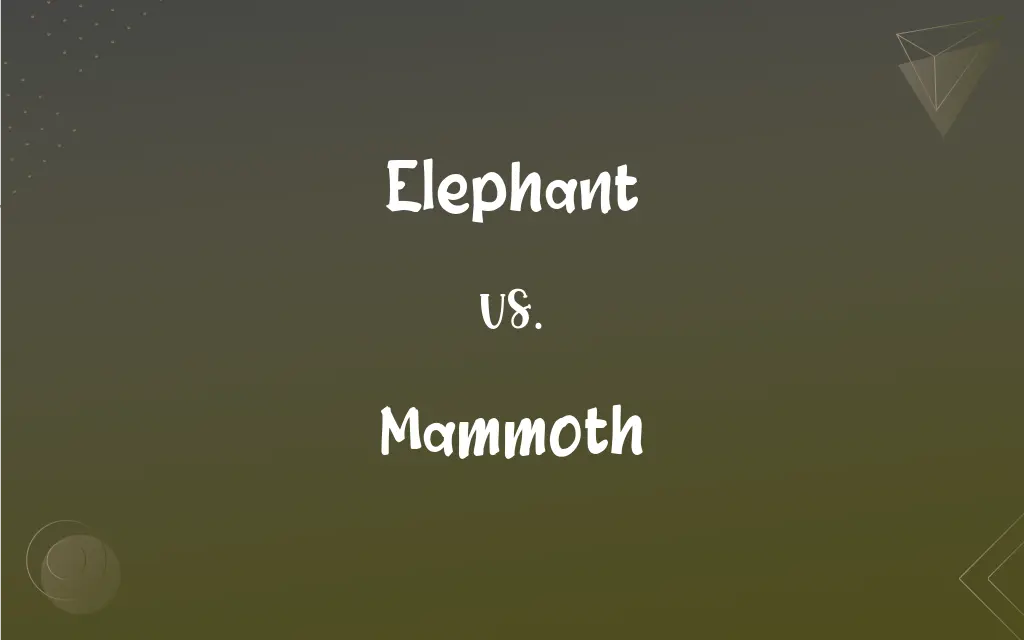Elephant vs. Mammoth: What's the Difference?
Edited by Aimie Carlson || By Janet White || Published on December 7, 2023
Elephants are modern, diverse species of large mammals; mammoths were an ancient, now-extinct genus of similar large mammals with distinct physical features like long curved tusks and a hump of fat on their backs.

Key Differences
Elephants are distinguished by their large ears (which differ in size between African and Asian species), curved tusks, and massive bodies. In contrast, mammoths, now extinct, were similar in size but had longer, curved tusks, a prominent hump on their back, and were adapted to cold environments with a thick, woolly coat.
Modern elephants inhabit African and Asian regions, adapted to a range of environments from savannas to forests. Mammoths, on the other hand, roamed across the Northern Hemisphere during the Pleistocene epoch, in habitats ranging from tundra to grasslands.
Elephants are known for their complex social structures, usually living in matriarchal groups. While less is known about mammoth social behavior, evidence suggests they might have had similar herd behaviors.
Today's elephants face threats from habitat loss and poaching, and are considered vulnerable or endangered. Mammoths, having faced extinction thousands of years ago, often spark discussions about de-extinction and conservation lessons.
Elephants hold significant cultural and symbolic value in various human societies. Mammoths, though extinct, captivate human imagination, symbolizing prehistoric times and are often featured in art and literature.
ADVERTISEMENT
Comparison Chart
Scientific Classification
Belong to the family Elephantidae, genus Loxodonta (African) and Elephas (Asian).
Were part of the family Elephantidae, genus Mammuthus.
Physical Traits
Have thinner, less hairy skin; ear size varies between African and Asian species.
Had thick, woolly fur and a pronounced hump of fat for insulation.
Time Period
Currently exist, though some species are endangered.
Lived during the Pleistocene epoch, now extinct.
Habitat Adaptation
Adapt to various climates, from savannas to forests.
Adapted to colder, often ice age environments.
Cultural Impact
Symbolize wisdom and memory; prominent in folklore and religion.
Represent prehistoric life; a subject of paleontological interest and media depiction.
ADVERTISEMENT
Elephant and Mammoth Definitions
Elephant
A symbol of wisdom and strength in various cultures.
In the parade, the decorated elephant symbolized royalty.
Mammoth
A symbol of the Ice Age and subject of many paleontological studies.
Scientists studied mammoth remains to understand past climates.
Elephant
A species facing environmental threats like habitat loss and poaching.
Conservation efforts focus on protecting the elephant's natural habitat.
Mammoth
Belonged to the genus Mammuthus, part of the elephant family.
The woolly mammoth is the most well-known species of its genus.
Elephant
The largest existing land animals, part of the family Elephantidae.
The African elephant is recognizable by its large, floppy ears.
Mammoth
An extinct large, woolly mammal, similar to but distinct from modern elephants.
A mammoth roamed these lands during the last Ice Age.
Elephant
A large, land-dwelling mammal known for its long trunk and big ears.
The elephant used its trunk to shower itself with water.
Mammoth
A prehistoric species known for its long curved tusks and large size.
The museum displayed a replica of a mammoth's skeleton.
Elephant
An animal with a long lifespan, complex social structure, and high intelligence.
The elephant remembered the way to the watering hole from years ago.
Mammoth
Often depicted in ancient art, reflecting its coexistence with early humans.
Cave paintings in Europe often feature the mammoth.
Elephant
Any of several very large herbivorous mammals of the family Elephantidae native to Africa, South Asia, and Southeast Asia, having thick, almost hairless skin, a long, flexible, prehensile trunk, upper incisors forming long curved tusks of ivory, and, in the African species, large fan-shaped ears.
Mammoth
Any of various extinct elephants of the genus Mammuthus of the Pliocene, Pleistocene, and Holocene Epochs, having ridged molars and often, as in the woolly mammoth, long tusks and hair.
Elephant
Any of various extinct animals of the family Elephantidae.
Mammoth
Something that is of great size.
FAQs
What is the primary distinction between an elephant and a mammoth?
Elephants are modern, diverse mammals with smaller ears and less hair, while mammoths were ancient, woolly, and had larger tusks.
Can elephants live in cold environments like mammoths did?
No, modern elephants are adapted to warmer environments and cannot survive in extreme cold.
Why are mammoths extinct?
Mammoths went extinct due to a combination of climate change and human hunting.
Were mammoths larger than current elephants?
Some mammoth species were larger, but size varied among different mammoth species.
Did mammoths have the same social structure as elephants?
While exact details are unknown, it's believed that mammoths had similar herd behaviors to modern elephants.
Are mammoths and elephants related?
Yes, both belong to the family Elephantidae, sharing a common ancestor.
What is the biggest threat to elephants today?
The biggest threats are habitat loss, human conflict, and poaching for ivory.
What is the lifespan of an elephant?
Elephants can live up to 60-70 years in the wild.
Did mammoths have any natural predators?
Yes, including humans and possibly large carnivores like saber-toothed cats.
How did mammoths adapt to Ice Age conditions?
They had thick fur, fat reserves, and specialized teeth for grazing on tough grass.
Why are mammoths often found in Ice Age art?
They coexisted with early humans who depicted them in cave paintings.
What is the main diet of elephants?
Elephants are herbivores, eating grass, leaves, fruit, and bark.
Did climate change affect mammoths similarly to how it affects modern elephants?
Yes, climate change played a role in mammoth extinction and currently threatens elephant habitats.
Are there any efforts to clone mammoths?
There are scientific discussions and experiments exploring the possibility of mammoth de-extinction through cloning.
Do elephants have any natural defenses against predators?
Yes, their size, strength, tusks, and social groups provide protection.
How do elephants communicate?
Elephants communicate through vocalizations, body language, and seismic signals.
How do African and Asian elephants differ from mammoths?
African and Asian elephants have different ear sizes and skin textures compared to the woolly, humpbacked mammoths.
Are there any living descendants of mammoths?
No direct descendants, but modern elephants are their closest living relatives.
What role do elephants play in their ecosystems?
Elephants are keystone species, playing crucial roles in maintaining the ecological balance.
How do elephant conservation efforts differ from mammoth de-extinction projects?
Elephant conservation focuses on protecting living species, while mammoth de-extinction explores bringing back extinct species.
About Author
Written by
Janet WhiteJanet White has been an esteemed writer and blogger for Difference Wiki. Holding a Master's degree in Science and Medical Journalism from the prestigious Boston University, she has consistently demonstrated her expertise and passion for her field. When she's not immersed in her work, Janet relishes her time exercising, delving into a good book, and cherishing moments with friends and family.
Edited by
Aimie CarlsonAimie Carlson, holding a master's degree in English literature, is a fervent English language enthusiast. She lends her writing talents to Difference Wiki, a prominent website that specializes in comparisons, offering readers insightful analyses that both captivate and inform.






































































